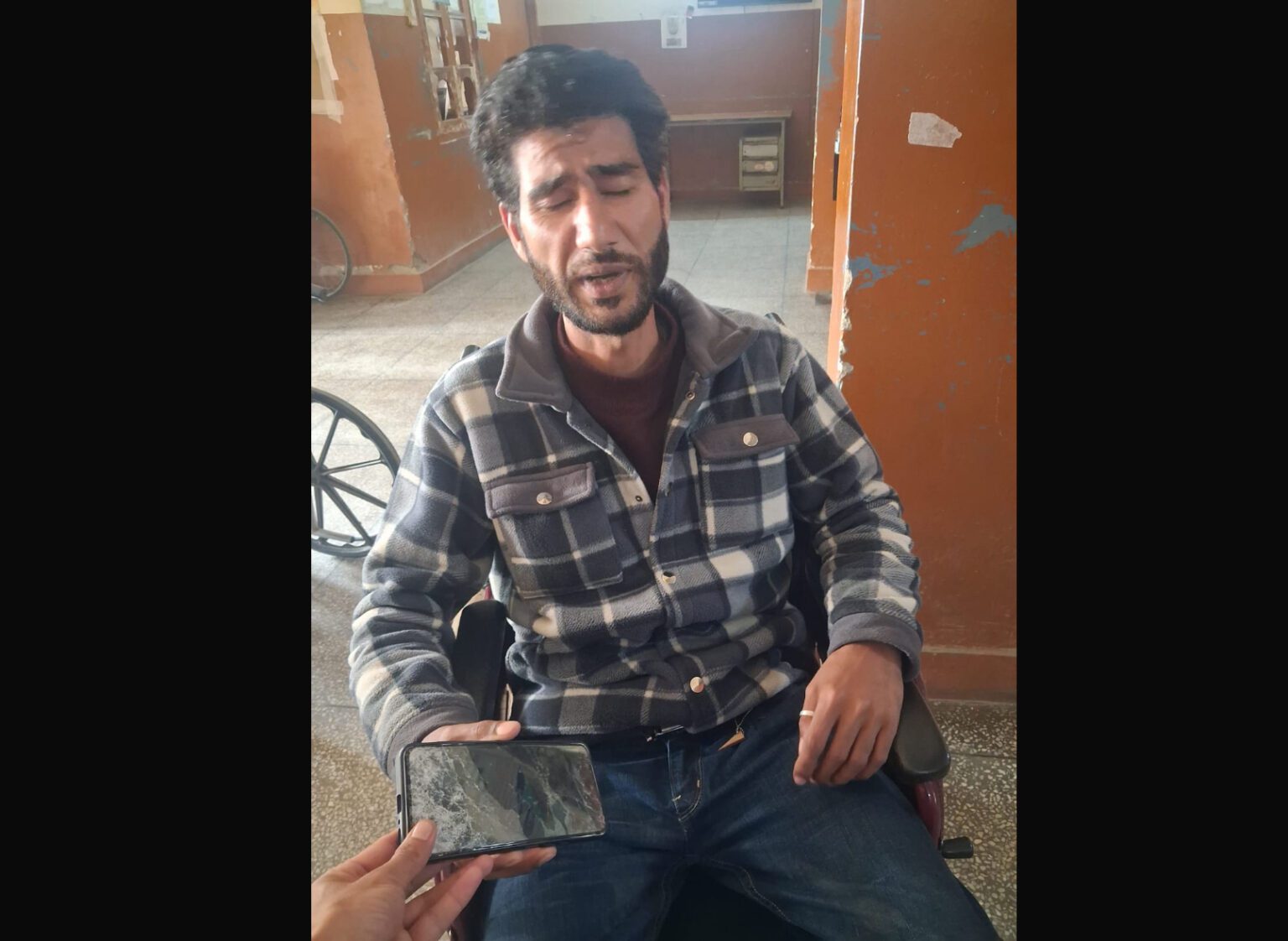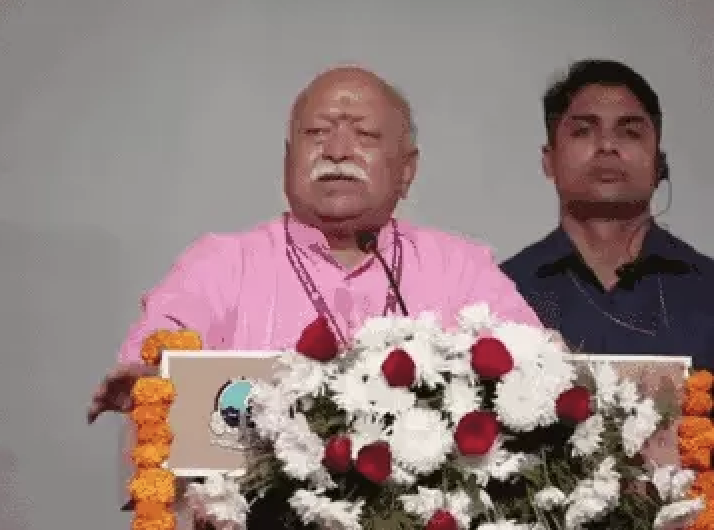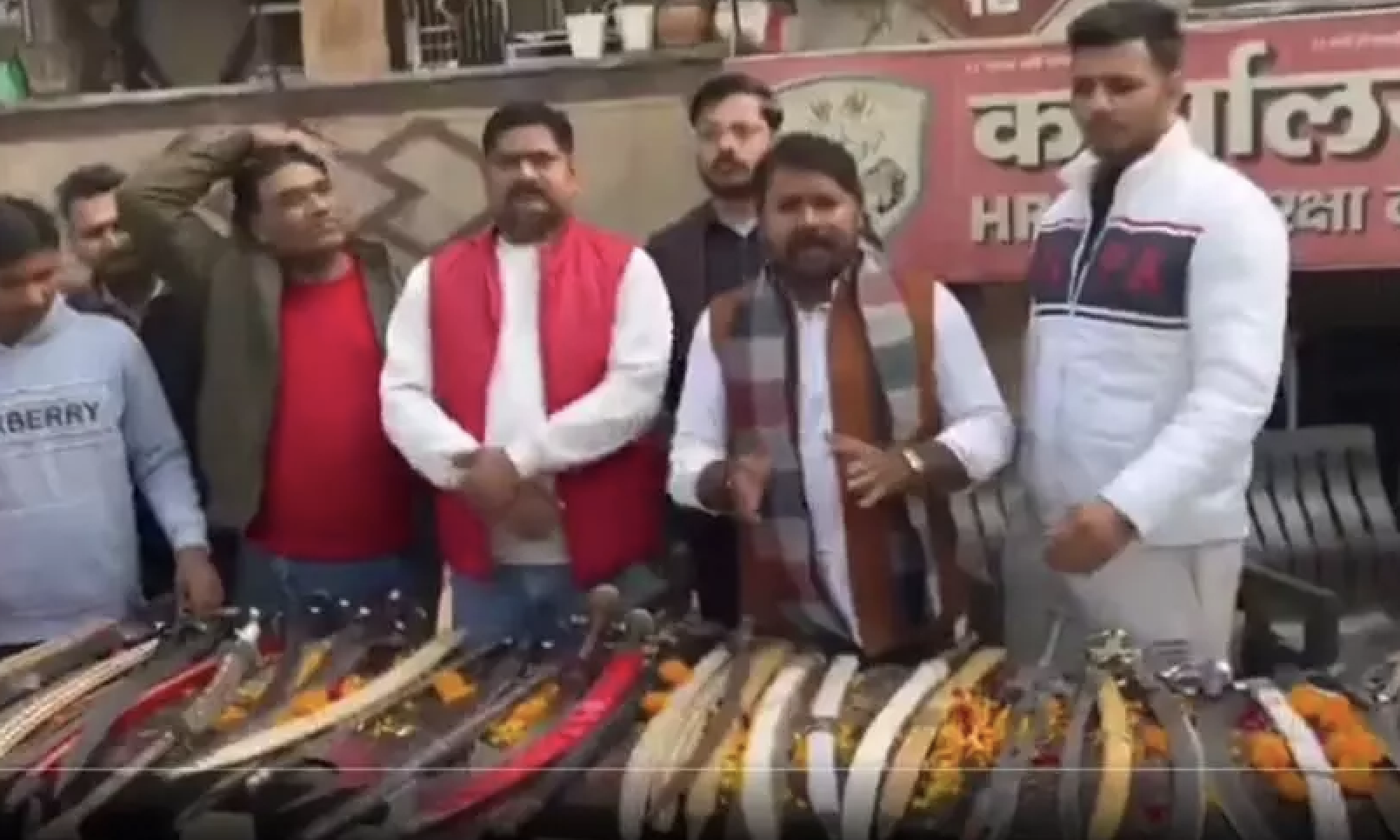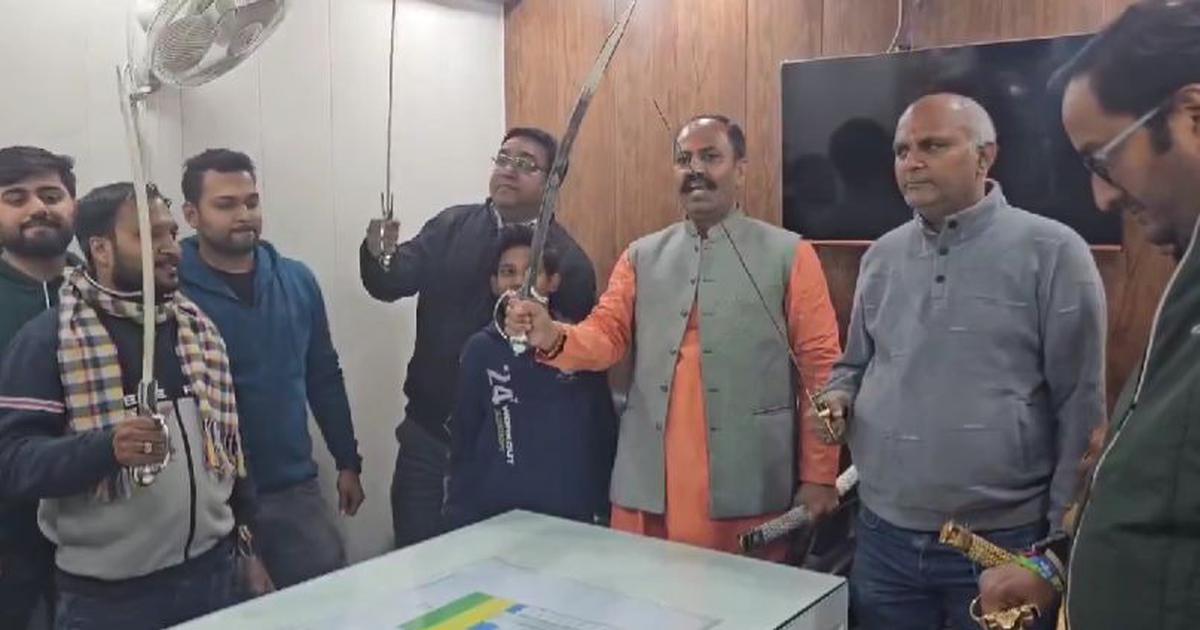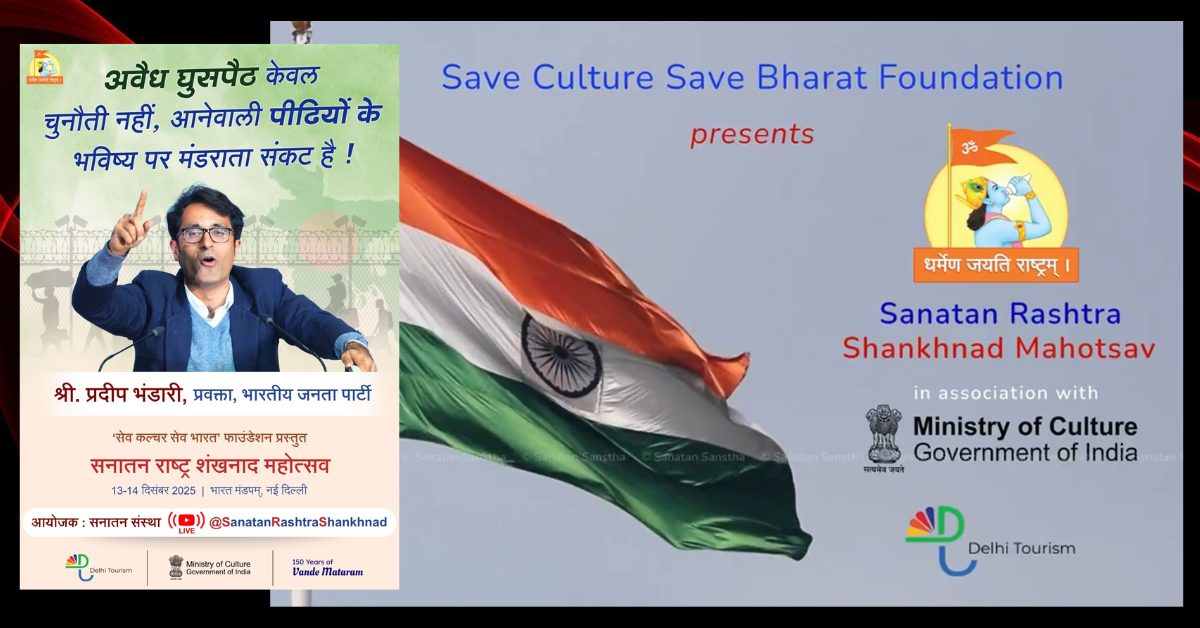In 1974, Swami Aseemanand completed his Masters in Physics from Burdwan University. Being influenced by the ideas of Swami Vivekananda, he initially worked with the Ramakrishna Mission among tribals. In 1977, he joined the Vanavasi Kalyan Ashram, the Rashtriya Swayamsevak Sangh affiliate which works with tribals. He first worked at Purulia for three years, then at Bastar, Madhya Pradesh, and then he moved to the Andamans and Nicobar Islands where he was involved in combating conversion to Christianity and promoting reconversion to Hinduism (Deobhankar 1999: 91–93).
In 1994–95, Aseemanand came to the Dangs on a tour organized by the Vanavasi Kalyan Ashram. During this trip, he observed the rising rate of conversion to Christianity and also discovered that Lord Ram and Shabari occupy some space in the local folklore and mythology. Aseemanand thought this aspect could be quite useful to check conversion to Christianity. He established his base in 1996–97 at Waghai, strategically located on the border of the Dangs and the plains of south Gujarat. Under Vanavasi Kalyan Ashram patronage, he set up hostels at Waghai for tribal boys and girls.
Aseemanand’s strategy for developing contact with Adivasi villages was innovative. First he toured the villages extensively, establishing a close rapport by communicating with the Adivasis in their own dialect. Then, he would visit the poorest families in a village, sit and dine with them, inquiring about their well-being. This had a great impact on the Dangis; so far no Hindu religious leader had visited their homes; hence they developed a lot of respect for him. To his great pleasure Aseemanand discovered that Hanuman was widely worshipped there. He went from door-to-door distributing pictures/lockets of Hanuman and copies of Hanuman Chalisa (a prayer book).
Aseemanand also found that most of the Dangis eat meat and drink liquor. Unlike other Hindu leaders, he did not ask them to change their dietary habits; rather, his advice was “khao pio kuch bhi karo lekin Hindu raho” (eat, drink, and do whatever you want, but remain Hindu). Aseemanand also distributed small cards with om inscribed in Hindi on one side and two messages (do mantra) on the other: “sankalp: jehad aur dharmantaran ki vichar ko vishwa se nirmul karenge” (Our resolve is to eliminate from the world the ideologies of jehad and conversion) and “jai ghosh: hamari vijay sunischit hai, kyun ki ham dharm ke sath hai” (Our Victory is certain as we are on the side of Dharma). Below these two mantras the caption was “Hindu dharma ki jai” (Victory of Hindu Dharma).
As Aseemanand’s popularity was growing, so also was the antagonism between non-Christian and Christian Adivasis. In 1998, on Christmas day, the Sangh Parivar organized a big rally at Ahwa, the district headquarters of the Dangs, protesting against conversion to Christianity. Parivar organizations such as Hindu Jagaran Manch, Vishwa Hindu Parishad, and Bajrang Dal mobilized the Adivasis, raising slogans such as “Hindu jage, christi bhage” (Hindus awake, Christians will flee).
What followed this rally was a series of attacks on churches and Christian institutions in the district; between December 25, 1998 and January 3, 1999, twenty-four churches, three schools, and six houses and shops were burnt, destroyed, or damaged, and nine tribal Christians suffered serious injuries (Gonzalves 1999). The Sangh Parivar was gaining in confidence as its political affiliate the Bharatiya Janata Party was in power in Gujarat as well as in New Delhi. Prime Minister Atal Behari Vajpayee called for a national debate on conversion. Aseemanand intensified his campaign.
The Idea of a Temple
Aseemanand developed the idea of a temple after a visit to the village of Subir. Local people told him that this was the village where Shabari lived. They showed him a pond called Pampa Sarovar which is mentioned in the Ramayan, and also told him that Matang Rishi, Shabari’s guru, had had an ashram in the vicinity. Then they took him to Chamak Dungar (Shining Mountain) and showed him three stones where Shabari had sat with Ram and Lakshman and given them berries to eat. Coincidentally, another Hindu holy man who had been visiting Subir frequently, one Swami Ramdasji, also arrived there the same day as Aseemanand, and together they explored the idea of erecting a temple on the hill top.
Soon after Aseemanand returned to his ashram at Waghai, he received a phone call from one Ramjibhai Rupala of Ahmedabad. During their conversation, Rupala disclosed that he had a Plaster of Paris image of Ma Shabari which he would gladly donate. Aseemanand calls this telephone conversation a sanyog (a providential occurrence). After accepting Rupala’s offer, the forest at Chamak Dungar was cleared in January 1999, and the Shabari image was installed in a small makeshift hut.
From 1999 onwards, every year on the day of Sharad Purnima, this image was taken out in a procession in a jeep decorated as a chariot, covering several villages in the Dangs; the objective was to connect the Adivasis with Ram and Shabari. This procession—the Devasthan Yatra—enhanced Ram’s significance to tribals in the area and laid the groundwork for the construction of a temple.
The Making of a Dham
Select Hindu temples are associated with a Dham, that is, an extended sacred territory around the temple. In order to construct such a Dham for the incipient Shabari temple, Aseemanand emphasized the sacred nature of some local mythological sites which were once supposedly linked to the Ramayan. For instance, Pampa Sarovar’s Ramayan link (see above) was re-emphasized. In the Ramayan, Pampa Sarovar was located near the Pushkarini River; the Purna River, which flows in the Dangs, has now been identified as the Pushkarini.
The Ramayan also describes trees near Pampa Sarovar as being full of fragrant flowers (karanja pushpa); Karanjada village was interpreted as being named after these flowery trees. Matang Parvat, the nearby mountain, came to be identified as the abode of Matang Rishi. Picturesque Unnai, having a hot water spring and a temple to goddess Unnai Mata, was re-interpreted as having been created by Ram’s arrow, as he sought to cure one Sarvang Rishi.
Anjan Kund was identified as the bathing pool of Hanuman’s mother Anjani Devi; it therefore followed that Hanuman was born in the nearby hills. It was also asserted that certain caves resembled the description of Sugriv’s abode in Ramayan. A stone slab was also discovered on which Lakshman supposedly sharpened his arrow. Hanuman supposedly followed the tracks of charans (footprints) in search of Sita; the presence of the Charan community in the locality again reinforced the Ram connection. In this way, then, the sacred territory of the Shabari Dham (Dixit 2004) was constructed as an appropriate environment for the Shabari temple.
A trust named Shabari Maa Seva Samiti was set up to undertake the temple construction. First, the land where the temple was to be erected was purchased from Ramubhai, a local tribal. Then, Narayandasji Swami of Santrampur, Nadiad, introduced Aseemanand to Morari Bapu, Gujarat’s most popular Ramayan Kathakar (Ramayan Reciter). Aseemanand organized for Morari Bapu to deliver a katha at the Shabari Dham. The katha was to achieve the following objectives: to further popularize Ramayan among the Adivasis, thereby consolidating the mythical/historical link between Dangs Adivasis and Ram; to raise resources for temple construction; and as a show of strength, to counter Christian influence.
On October 22, 2002, the katha began outside the Jesuit Centre of Subir. Then Gujarat chief minister, Narendra Modi, inaugurated the katha. Free transport, lodging, and food were provided for tribals; 45,000 people, out of whom 25,000 were from the Dangs, came to attend the katha, which continued for a week. About 60 lakh (6 million) rupees were raised, out of which 40 lakh (4 million) were spent on the arrangement of katha itself and the rest was kept for the temple construction. Most of the donations came from the businessmen of Surat and Navsari, primarily due to the presence of Morari Bapu. During the katha, Morari Bapu proposed the idea of a Shabari Kumbh.
The construction work commenced soon after. The bhumi pujan (foundation laying) ceremony was performed by a Dangi Bhagat following Dangi cultural rituals. During the construction period, myths about the site continued to be developed. For example, it was said that a light, known as Prakash Punj, shines from Chamak Dungar (the Shining Mountain) once a year, and it is Lord Ram who flashes this light. Swami Aseemanand had seen Prakash Punj during his stay at Subir. Local Adivasis always believed that Prakash Punj would bring a miracle (chamatkar) one day; now the construction of this huge temple was seen as a miracle.
Certain miracles were reported from the construction site as well. For instance, when one worker was leveling the land his tractor got stuck on the slope of the hill and was about to fall down. His brother desperately prayed to Shabari Mata and all of a sudden he saw a flash of light and the tractor came out with a jerk, thus saving his life. Such myths popularized Shabari as a powerful Goddess in tribal imagination and created enthusiasm among the Dangis for the Shabari temple.
Aseemanand wished the architecture of the temple to conform with local myths. The villagers of Subir believed that Shabari Mata had strategically chosen Chamak Dungar because she could see the entry of Lord Ram from all sides, as she was not sure of the direction he would come from. Keeping this in mind, Aseemanand instructed the architect, Ishawarbhai, to design this temple so that it would be open from all sides. Construction was carried out under the supervision of Kishore Gavit, an Adivasi civil-engineer-turned contractor. Gavit was a Vishwa Hindu Parishad worker and became a close associate of Aseemanand. Construction was completed in 2004; it took little over a year and the total expense was 3,000,000 rupees. Though this temple seems big in a tribal landscape (150 feet length, 75 feet width, and 25 feet height), its architecture is not elaborate if one compares it with other major Hindu and Jain temples in Gujarat. It is simple, utilitarian, and cost-effective.
The Temple
The sanctum sanctorum (garbha griha) has white marble statues of Ram, Lakshman, and Shabari which were sculpted in Jaipur, Rajasthan. The sanctum sanctorum retains the three stones on which Ram, Lakshman, and Shabari supposedly sat as she gave them berries. The nature of representation here raises a fundamental question: Who is the main deity?—Shabari or Ram? (Figure 1).
The three statues as well as the three stones represent a clear hierarchy: Ram, Lakshman, and Shabari in descending order. Shabari sits on the right side of Ram. This arrangement offers several meanings. It could simply mean that sitting next to Ram, Shabari is offering him berries. Analyzing the iconography of Dakshinamurti, however, Hans Bakker (2004) points out the way in which this represents the traditional ritualistic position of a student sitting at the right side of the teacher. The student sits at the right side of Mahadev’s visual manifestation and sees Him, His rupa, His benign epiphany, in front of him.
This example shows how Brahmanic ritual patterns manifest in image worship; Shabari’s representation confirms her status as a devotee. Ram is undisputedly the Supreme God and Shabari attained sainthood/divinity only by Ram’s blessings. The iconography makes Shabari peripheral: while Ram’s face is completely visible, Shabari only looks towards Ram. When Hindus go to the temple, “Their eyes meet the powerful, eternal gaze of the eyes of God. It is called darçan, ‘seeing’ the divine image, and it is the single most common and significant element of Hindu worship” (Eck 1998: 1). While one gets a complete darshan of Ram, then, there is no scope of having direct eye contact with Shabari.
The stones also provide a neat representation of hierarchy (Figure 2); Shabari’s stone is the smallest of all. The idea behind this representation appears to be very clear and categorical. Shabari has no existence independent of Ram. She was an ordinary Bhil Adivasi woman before she met Ram and became extraordinary only because Ram blessed her. Hence, the Shabari temple could not be conceived without Ram. Ram appears majestic and Shabari marginal, though both share the space in the sanctum sanctorum.
Besides the three deities, the temple has other gods and goddesses in its complex. A Shiva linga has been installed; next to it stands a small vertical wooden slab with five painted pictures: sun, moon, tiger, snake, and peacock in descending order. In front of this wooden slab there are five stones representing these five traditional Adivasi gods. Whereas Lord Shiva is installed under a shed, the five stones and the wooden slab are out in the open (Figure 3). This is an indication that tribal gods, although present, are peripheral to the Ram-Shabari temple, looking neglected and left out.
Consecrating the Temple: The Shabari Kumbh
Once the temple was constructed, it had to be consecrated in a grand way. Sangh Parivar found an ideal strategy in Morari Bapu’s idea of a Kumbh. What would be the rationale of a fifth Kumbh not sanctified by Hindu traditions? It appears to have been simply the sanction of the most popular Hindu sant of Gujarat. The Sangh has frequently demonstrated an enthusiasm for the invention of tradition and this is one further example of the tendency.
It was claimed that this new Kumbh would be designed along the model of the traditional Kumbhs. Indeed, the Kumbh mela has never been purely a religious gathering; rather, “it was an intriguing blend of religiosity, trade, and social communication, sharing the recreational elements of a fair” (Maclean 2008: 3–4). In this sense, the Shabari Kumbh, like traditional Kumbhs, went beyond the religious. The Sangh was primarily concerned with Hinduizing the Adivasis in the name of samajik samrasta (social harmony) and, more importantly, mobilizing them against conversion to Christianity.
Sadhus, Sangh, and Sarkar: Fusion of Shabda, Mantra and Tantra
Shabari Kumbh, coinciding with Magh Purnima, was organized for three days, February 11–13, 2006. As Narendra Modi commented, this massive mobilization was the culmination of “shabda (revelation), mantra (hymn) and tantra (administration).” Morari Bapu’s revelation (shabda) became a hymn/vow (mantra) for the Sangh Parivar to organize this Kumbh, and Modi’s state machinery (tantra) provided the logistical support to ensure its success. Shabari Kumbh, then, became a confluence of three streams of discourse: Sadhus, Sangh, and Sarkar (government) developed a coherent approach, focused primarily on the castigation of Christian missionaries and the appeal to tribals to resist conversion and become part of the “garden of Hinduism.”
“All tribals are Hindus,” observed the Shankaracharya of Joshimath during the Kumbh. Sadhus, one after another, reiterated this position. They rejected the “false propaganda” that Aryan invaders pushed the Adivasis to the forests. Emphasizing the greatness of Hindu religion, Satyamitranandgiri Maharaj of Bharat Mata Temple (Haridwar) explained that Hinduism has always believed in equality and holds none as big or small, as demonstrated by the fact that “both Shankaracharya and Ravidas were equal” (Shankaracharya ke sath Ravi Das bhi the). The Shankaracharya also called for “Social Kumbhs” to bring all Hindus together on one platform and suggested four new Kumbh sites: Chhattisgarh, Jharkhand, Uttaranchal, and the Northeast.
Many Sadhus at the Kumbh also demanded that all induced conversions—commonly labeled “poaching”—stop forthwith. Morari Bapu called Christian missionaries dambhis (arrogant) and pakhandis (charlatans) by claiming that they do not follow Christ. Quoting the Bible, he reminded them that Christ forbade conversions. Hence, it “is hypocrisy to not follow what you preach. When Bible says do not convert, please don’t. It is great that you are good medicos, and have money to help poor and ailing. But once they have been healed, let them go back home [to their parent religion] as good doctors do. ‘ghar jana koi gunah nahin hai’ (Homecoming is not a sin).” However, he assured Christian minorities not to be scared, as the Kumbh reflected the Hindu ethos of peace and tolerance.
Satyamitranandgiri urged the people to keep the pollution of conversion away from India and advised them to follow Madan Mohan Malaviya’s prescription of havan, hanuman chalisa, bhandara in every village. He asked Hindus to imbibe the Sikh tradition of langar (free community dining) in order to promote and consolidate Hindu brotherhood. Shambhunathji Maharaj, a militant Sadhu and Vishwa Hindu Parishad activist, not only warned Christian missionaries, but also castigated the Muslims. He appealed to the audience to support only those political leaders and parties who are on the side of Hindutva. He pleaded for collaboration between Dharmaguru (Sadhus), Bhaktajan (disciples/swayamsevaks), and Prashasan (the state).
Asaram Bapu began by asking the audience to chant “Ram Ram” continuously for some minutes. He stated that “He who does not take Ram’s name is a traitor.” Christian missionaries, he claimed, had been committing the greatest sin by snatching people’s religion. His remedy for conversion focused on anna (food), arogya (health), and aradhana (prayer). He concluded his speech by congratulating the Rashtriya Swayamsevak Sangh chief and his swayamsevaks for what he called “this grand anti-conversion congregation.”
The Sangh’s Discourse
In his speech at the Kumbh, the then Rashtriya Swayamsevak Sangh chief K. S. Sudarshan observed that only those tribals who lived in the forest should be called Vanavasis; those who lived in the cities should not be called so. This nuance is significant. A new elite has emerged among the Adivasis, particularly in Gujarat. This educated and economically prosperous elite prefers not to be called either Adivasi or Vanavasi, preferring to be part of the mainstream Hindu identity rather than sticking to its traditional tribal identity. This elite has been at the forefront of the Hinduization campaign.
Sudarshan urged the Sadhus to increase their presence in the Adivasi areas and intensify their Hinduization campaign with the message that “Vanavasis/ Janajatis are part of the extended Hindu family.” Sudarshan also observed that anti-Hindu forces were playing havoc with the tribal social structure through induced conversions and this needs to be “combated with everything at our command,” including tactics like “kapat” (deceit), which Lord Krishna used in the Mahabharata.
The Sangh activist Sadhvi Rithambara also spoke at the Kumbh. She asked Hindus to confront Christian missionaries head on and take up arms to defend their religion, becoming Ram’s banar sena and sounding the bugle of Hindu Rashtra: “Hindu child is lion and Hindu youth is the conqueror of the world.” Rithambara urged them to take sankh in one hand and shastra in the other to stop conversion and asked the tribals to become dharma rakshak (protectors of dharma). Her message was: “Don’t get converted and stop others from getting converted.”
The Sarkar’s Discourse
Narendra Modi, then chief minister of Gujarat, swearing by the Indian Constitution, declared that it was his constitutional duty to prevent conversions. He also ridiculed “Macaulay putras” (progenies of Lord Macaulay) for opposing the Kumbh and claimed to have provided rupees 800 crores (8,000 million) for the development of the district. He promised to develop Shabari Dham further as a pilgrim center, incorporating it in the government’s tourism promotion strategy.
All three discourses underlined a common perspective: first, Adivasis are Hindus and their culture is only a sub-culture of Hinduism; second, Christian missionaries have been converting innocent Adivasis by fraud, lure, and deceit and have to be confronted not only with stringent anti-conversion laws, but also with large scale mobilizations of this kind; third, a well-thought out strategy to check the march of Christianity in tribal areas needs the collective endeavor of Sadhus, Sangh, and Sarkar; while the Sadhus would intensify the Hinduization of the Adivasis and the Sangh would carry out its Hindutva agenda, the Sarkar would boost their campaign by pushing through tough anti-conversion laws and by undertaking a suitable developmental agenda.
A Grand Consecration
The Shabari Kumbh was a grand success. The Sangh Parivar has provided the following statistics: about 800,000 pilgrims visited the Kumbh, including delegations from all the states and 10 foreign nations; about 500 saints took part in it; 21 folk dance groups from 17 states provided entertainment; more than 25,000 people reached the venue by walking distances between 40 to 400 km; gliders showered flowers at the time of inauguration; there was a live telecast of the events on huge screens at 6 places; loudspeakers covered a distance of 10 km from the venue; the sabha mandap (pandal) covered an area of 53,000 square meters; 2,000 toilets were set up and 8,000 tube lights and 53,000 bulbs were powered by 20 generators; 100 tanks of 10,000 litres each provided drinking water; 9 bhojanshalas (kitchens) fed one million people during the festivities; 33 Out Patient Departments, 2 indoor hospitals, 15 mobile vans, 180 doctors were engaged; 5,000 managers (prabandhaks) were on duty, mainly Sangh volunteers (4,000 men and 1,000 women); 160 media personnel gave coverage to the Kumbh through 17 news channels, 8 national newspapers, 10 weeklies, and vernacular newspapers consisting of 15 Hindi, 6 Gujarati, 9 Marathi and 1 Bengali.
The Sangh statistics might have exaggerated the total number of visitors, but the Kumbh brought at least half a million people to visit this new temple, to have a glimpse of Ram and Shabari, to take a holy dip in the Pampa Sarovar, to listen to the pravachans (discourses) of the Sadhus, and of course to enjoy the festive occasion. Slogans like “Ram Lakshman Shabari ki, Jai Bolo Matang ki” (Hail Victory of Ram, Lakshman, Shabari, and Matang) rent the air. Thus, Shabari Dham was legitimized as a new center of Hindu pilgrimage.
For the Rashtriya Swayamsevak Sangh, it was a national festival and represented renewed hope of a resurgent India, a significant event in Vanavasi history, comparable to the resistance movement of Birsa Munda against British colonialism. Unsurprisingly, this huge show of strength and call for “Dharma Jagaran” (religious awakening) at the Kumbh made ordinary citizens belonging to the minority Christian community feel unsafe and insecure. Though no Christian tribal was reconverted in public view during the three-day congregation, the charged atmosphere created fear that they would be forced to reconvert after the Kumbh.
A CD reportedly being circulated by the Sangh Parivar showed visuals of a tank with people washing themselves, with the caption, “ghar vapsi,” a reference to the Sangh’s reconversion ceremony. In an interview, an influential tribal elite of Jog Thava village and a close associate of the Sangh Parivar disclosed that after the Kumbh they would quietly take five-six Christian families of the village to Unnai and reconvert them.
Resistance and Adivasi Assertion
Some human rights activists, church leaders, and secular individuals and groups resisted the Shabari Kumbh, alleging that it threatened peace, communal harmony, tribal culture, and the environment in the Dangs. Both print and electronic media highlighted the political objectives behind the congregation and how it would have an adverse impact on the environment and Adivasi culture. The tribal organization Adivasi Ekta Parishad passed a resolution against the Kumbh, claiming that it threatened Adivasi culture, language, and their movement for empowerment.
On February 11–12, during the days of Shabari Kumbh, some Adivasi activists organized a parallel Dungar Dev Puja at Bhalkhet village. Initially, the district administration refused to permit any public congregation during the Shabari Kumbh. The organizers took the plea that it was a private religious function in order to avoid confrontation. The Puja began on the 11th morning at Mangubhai’s house at Bhalkhet; and all through that night the Adivasis sang and danced. On the next day, the Puja took place on Kawadia hillock, near Bhenskhatri and at night a bakara (goat) feast was organized.
Only 1,500 Adivasis participated in this event, in contrast to half a million in the Shabari Kumbh. “We are not Hindus,” claimed Bharat Pawar, one of the main organizers. Differentiating Adivasis from Hindus, he explained: “Unlike them, we sacrifice goats and chicken to satisfy our goddesses. We worship our ancestors in a different manner. We are animists as we worship Baghdeo (tiger god) and Nagdeo (snake god). We worship Mother Nature: stones, the sun and the moon.”
He accused the Rashtriya Swayamsevak Sangh of dividing and exploiting the Adivasis in the name of religion and not having any development agenda. He also claimed that the Sangh Parivar had been silent on key issues like tribal rights over forestland, migration, and exploitation; its only plank was “ghar vapsi.” “We are Adivasis, neither Hindus nor Christians; both the Sangh Parivar as well as some Christian missionaries are making efforts to obliterate our indigenous culture,” observed Pawar. One tribal organization, the Adivasi Jan Jagran Manch, was also claiming that Adivasis are not Hindus and they have nothing to do with the Kumbh Mela.
The Temple, Adivasis, and Hindutva Politics
The Shabari Temple represents a kind of Hinduism hitherto unknown to the local Adivasis. An imposing temple, impressive marble deities, an alien mode of worship, mega festivals, and a stream of non-Adivasi visitors were new additions to the everyday life of the Adivasis. Swami Aseemanand resided in a small hut in the temple complex, assuming the role of a guru.
Like any other Hindu temple, arati was held every morning and evening, but this was Shabari Mata arati. Though this arati was similar to the ones held in a Hindu temple, it was not performed by a Brahmin priest but by an Adivasi youth, Mansukhabhai, who also took care of the temple. Free lunch (prasad) was distributed to pilgrims everyday; on average 150–200 visitors came daily. The Shabaridham Trust also periodically organized Ramayan katha at various places to disseminate Hinduism as well as to raise funds.
Additional religious festivals have been developed at the temple. One such festival, Ram Agaman Mahotsav, is now celebrated on every Makar Sankranti (January 14), as local Adivasis believe that Ram-Shabari milan (meeting) took place on that day. The festival begins on the 11th with a procession; the organizing committee meticulously draws the route map each year, earmarking the villages to be covered during the next five days. Three youths (two boys and a girl) enacting Ram, Lakshaman, and Shabari accompany the procession, observing maun vrat (vow of silence), and breaking their silence only after they are back at Shabari Dham. Villagers join the procession enthusiastically when it passes through their village. Bhajan (devotional song) programs are organized wherever the procession halts at night.
On Makar Sankranti day, a big fair (mela) is organized at Shabari Dham which attracts a large number of Adivasis. For instance, around 10,000 people attended this fair in 2008. The Seva Samiti distributes free food and also organizes programs for children. Another festival, Ma Shabari Birth Anniversary, is celebrated on the Sharad Purnima day. From a simple bhajan recital program, it has now developed into a major festival. Through these festivals, the Shabari Temple has become a popular religious destination and pilgrimage center. Hindu Pilgrim centers generally develop into commercial ones as well; and the trend has already set in with the opening of the “Maa Shabari Resort” by a close aide of Aseemanand, Kishore Gavit, a construction contractor who was the general secretary of Akhil Bharatiya Shabarikumbh Samaroh Ayojan Samiti.
The Shabari Temple has also become a site for Hindu nationalist activism. For the first time, the Bharatiya Janata Party’s nominee from the Dangs constituency was elected to the Gujarat Legislative Assembly in 2007. This young MLA, who defeated a veteran Congress nominee, was close to Aseemanand. Besides his involvement in electoral politics, it has been alleged that Aseemanand is linked to Sameer Kulkarni, one of the accused in the Malegaon bomb case and a promoter of Abhinav Bharat, a “Hindu terrorist” organization.[1] The Shabari Temple complex was searched in connection with this allegation, and Aseemanand went underground for some time.
Conclusion
The perception of mainstream Hindu society has been changing towards the Adivasis. Once called “Kaliparaj” (black-skinned people) in Gujarat, they were looked down upon as “jungali” (uncivilized). Even Mahatma Gandhi called them “raniparaj” (people living with wild animals) (G. Shah 1999). The Indian Constitution recognized them as “Anusuchit Janjati” (Scheduled Tribe).
M. S. Golwalkar, the Rashtriya Swayamsevak Sangh ideologue, rejected the term Adivasis and called them Vanavasis (forest dwellers)—the backward Hindus who need to be Hinduized. In its search for a unified Hindu identity, the Sangh Parivar realized the need to bring tribals into the Hindutva fold. However, this became a challenging task as Christian missionaries had been actively working among the tribals since the colonial period, primarily focusing on their education and health along with proselytization.
Before the Sangh Parivar’s entry into the tribal district of Dangs, many Hindu religious sects were already active in the area and were Hinduizing the Adivasis. This became an advantage to the Parivar as the Adivasis were familiar with Hindu religiosity, idioms, and culture. The Sangh Parivar deputed Swami Aseemanand to the Dangs. In order to strike a chord with the Adivasis and arrest the growth of Christianity, Aseemanand carved the Shabari tradition from a combination of local Adivasi folklore and the Ramayan. She was elevated to the status of a deity and a temple was dedicated to her. The temple building exercise itself showed the fascinating process of Hinduization.
Without the Sangh, Shabari would have remained another anonymous rugged black stone in Chamak Dongar (the Shining Mountain). Hindutva has transformed her by carving out a white marble deity and rehabilitating her in a grand temple. Hindutva has certainly made Shabari a key deity; but, as the nature of her representation reveals, she nevertheless occupies a relatively marginal space; it is Ram who looms large—in the garbha griha as well as in street processions. If, then, she has found a place among the Hindu pantheon of gods and goddesses, her position remains much lower down the hierarchical order. It is obvious that Ram is considered the supreme symbol of the Hindu Nation. Shabari’s rehabilitation remains conditional and strategic. Despite elevation, she and her descendants still remain on the margins of Hinduism.
This article is excerpted from a paper written in 2010. Read the full paper here.


